
James Hoard
-
Posts
632 -
Joined
-
Last visited
-
Days Won
1
Content Type
Profiles
Forums
Blogs
Gallery
Events
Store
Posts posted by James Hoard
-
-
James,
You argue the case well and I agree. I seem to recall seeing a picture of this gentlemen some years ago and being unable to identify this order. Do you have access to further details of this book?
Thaks,
Owain
Owain,
I am actually looking for a library that has all Said-Reute's publications to see if there may by any more. It looks like the Library of the School of Oriental and African Studies in London may be the best bet. However, I will need to arrange for a day pass, because it is not ordinarily open to members of the public. And it is best to leave it for a ime when I can afford to spend the best part of a Saturday on the ask.
Cheers,
James
0 -
James 's illustration could to bear this out but is not clear enough to come to a firm conclusion.
Actually, if one looks carefully at the b/w photograph I posted, one can conclude quite a lot. Firstly, if one looks particularly at the rim and rays of the star they are of exacly the same shape as the badge orignally posted. The same longer rays, thin, wavy and reminiscent of the Star of India. Separated by the same shaped shorter rays between them as in the badge - straight, arranged in threes, two longer than the one in the middle. The central disk surrounded by a raised enamelled band edged in he same metal as the rays.
It is not just the illustration either. Said-Reute says that he received the Saidi order 1st class on 10.10.1928 and was proud of it enough to show himself wearing it in the book. The other orders that he received were (courtesy of Chrisopher Buyers): Brilliant star of Zanzibar 2nd class (2.7.1929), Lion and Sun of Persia 3rd class (1913), Nishan-i-Osmanieh 3rd class (1903), and Nobility Nishan-i-Mejidieh 4th class (1895) of Turkey, and the Red Eagle of Prussia 4th class (1912). Clearly, the picture is not of any one of the latter.
Cheers,
James
0 -
Thank you eitze, I have learned a lot from your posts here abou Zim decorations.
As for Mugabe's order of wear. At least this picture shows some improvement. For several years he used to wear his star above his ribbon bar. The latter used to be afixed somewhere down near his bottom left pocket.
Cheers,
James
0 -
No clue....
JC
It is the Saudi order. I think the Badr Chain (???)
0 -
When it comes to non-British names, the correspondence between the name as rendered on the medal and the name in the London Gazette (saying nothing about the real name) seems to be more variable than usual (and that's saying a lot) when it comes to the B.E.M. Almost all of mine, of course, are to Indians -- military, civil, and merchant navy -- and it can be a challenge matching the medal to the gazette entries (whether LG or GoI), though, strangely, the recommendations are usually pretty good for name accuracy.
I picked up in Delhi a BEM to "Ibrehim Kawas Mohammad" and this researched out to "Mohammad Ibrehim Kawas - Surveyor, Department of Surveys Palestine" awarded B.E.M. LG 12 June 1941. The recommendation is elusive, though probably a retirement gift.
Amazing how Palestinian B.E.M.s seem to travel about the globe.
A nice one you snagged there!
All understood. But your man was a surveyor and surveyors do tend to travel. However, from the very full description given above about the occupation of kawas, one does not get the impression that it called for much travel.
The reason for the differences in names in the London Gazette is largely due to those being responsible for that publication at home having little or no knowledge of the outside world. The biggest problems arise when they try to make lists of people according to alphabetical surname, then make all sorts of incorrect assumptions over Muslim and Chinese names. They then convert them back again to full form with further errors. Now, if someone fills in a form with boxes in it for "given name", "surname" and "father's name" then the room for errors by someone who does not know about particular naming formats is almost endless.
Still, the Western world does not seem to have advanced all that much. After the 9th of September the US immigration authorities started carting away numbers of Malaysians because they used "bin" between their own given and fathers' last names.
0 -
A very interesting set of posts indeed.
Just to play devil's advocate, what evidence is there to link "Khalil Daoud Ikhwais" of Jerusalem to "Daoud Khalil" of the Sudan?
0 -
I fail to see how a bland relation of a few dates and facts amd giving a link to an Indian website could be highly anglocentric.
Please feel free to Americanise them as you see fit.
0 -
Actually, the nicknames for the various levels of the Order of St Michael & St George were in common use, certainly within both the Home Civil Service and the Foreign Office, for some considerable time before Yes, Minister was aired.
True, but the wikipedia article quotes "Yes Minister" as its source.
The explanations actually arose not from the Foreign or Home Civil Service, but in the Colonial Service. Due, largely, to the ascending power of the recipients as they climbed the career ladder. Best described in terms of their power over life and death. The order was not usually conferred on members of the Home Civil Service and Foreign Office diplomats did not hold power.
I think it was either Sir Bede Clifford or Sir Harry Luke who first wrote about the usages in their memoirs.
0 -
Knight Grand Cross of the Most Distinguished Order of Saint Michael and Saint George (GCMG = God calls Me God).
See:
http://en.wikipedia.org/wiki/Order_of_St_M...l_and_St_George
Sigh!
Only in the post book reading world could that tired ditty be ascribed to 'Yes Minister'.
Cheers,
James
0 -
Hello,
I never knew that Indian(or are were they considered British during this time) Officers flew fighters during WWII. When I think of India during WWII I think of foot soldiers. I came across a website that made me think for a moment.
 In other words NEAT........ Although I mostly dwell in the 18th centuery.
In other words NEAT........ Although I mostly dwell in the 18th centuery. 
website: http://indianairforce.nic.in/show_page.php?pg_id=14
Indians joined the Royal Flying Corps during the Great War and there are several examles of several winning gallantry awards. They were mostly young men who were already in the UK (or Europe) studying either at school or university.
A separate Indian Air Force was established in 1932 with six RAF officers, 19 'air soldiers' and 4 Westland biplanes. Though very small, it expanded rapidly after the establishment of Indian Volunteer Air Force during the second World War and served with distinction in the UK, coastal defence, Burma, the Defence of India, reconquest of Burma, Japanese bases in Thailand and South-East Asia. They also sent a unit to join the British Commonwealth Occupation Force in Japan. At war's end, their strength had reached 9 squadrons and 29,000 personnel who won something like 25 DFCs. They were honoured with the title 'Royal Indian Air Force' for their services by the King-Emperor George VI in March 1945.
See http://www.bharat-rakshak.com/IAF/History/1940s/index.html
Cheers,
James
0 -
Thank you, James for the great pictures!
On this photo Sobhusa II with order on the sash. It's first time I've seen that man wears the order without cloth!

Regards, IVB.
I think he may well have been caught unawares. He was given the GCMG as a bit of a surprise present from the Queen on his Diamond Jubilee. Princess Margaret had travelled all the way out there especially and he wasn't told that he was going to receive the order beforehand.
Nevertheless, he was a hugely dignified man. Equally at home in full uniform, evening dress or a grass skirt. In the 1920s and 1930s he would have been dressed in a Household Cavalry uniform with a shining helmet and plumes.
Cheers,
James
0 -
Yes indeed, all the pictures except for the b/w one are of Mswati III. Sorry to say that I do not know which princess.
Cheers,
James.
0 -
Now here is a further mystery.

A picture of the present King's father Sobhuza II with the last but one British Commissioner, Sir Brian Marwick. The latter is obviously not wearing his KBE which he received in June 1963.
Sobhuza was made a CBE in 1950 and KBE in 1966, but he seems to wearing an entirely different and unidentifiable breast star and neck badge. Could Swaziland already have insituted the Royal Order of Sobhuza II or another order around that period?
Cheers,
James
0 -
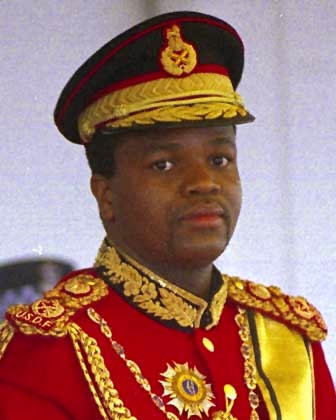
Another version of the Royal Order of Sobhuza II star on the right breast?
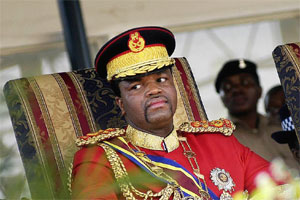
Unknown sash, sar and collar.
Cheers,
James
0 -
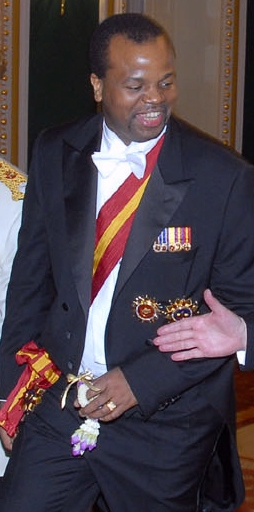
I do not know which order this sash belongs to, but my guess is that it goes with the second star on the King's left breast. The first star on the right appears to be the Swazi Royal Family Order.
Cheers,
James
0 -
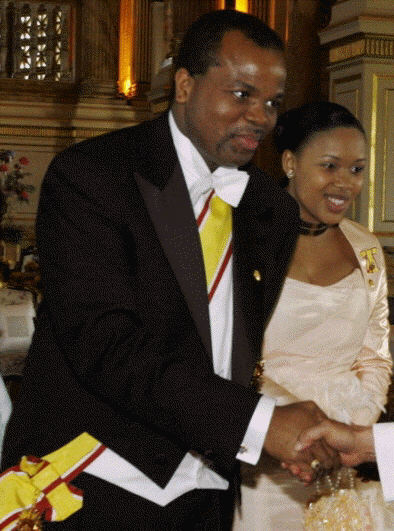
Given tha both the King and Princess seem to be wearing the same order, my guess is that this ribbon of broad yellow with brown/russet edge stripes separated by a thin white stripe is the Swazi Royal Family Order.
Cheers,
James
0 -
Does anyone have pictures of these Orders and Medals?
Doc
As I said, I tried posting some pictures of the King wearing orders but they were too big.
Here is my second atempt.
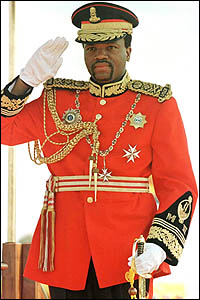
Full view

Close up.
The star on the right breas appears to be the Royal Order of Sobhuza II. The star on the bottom left breast is his Order of St John of Jerusalem, to which he was appoined on 11.11.1991, but the collar chain is unknown to me. The star on the top left breast is obviously one of the newer orders, but which one?
Cheers,
James
0 -
Thanks Arthur, that is very useful to have.
If you like I can send you some photographs of the King wearing some of these orders.
I tried posting them but they take up too much memory. If I cut them down to size, you will not be able to see very much.
Cheers,
James
0 -
Does anyone have details of the Swazi orders and decorations?
It seems that there are at least four orders, as follows:
The Royal Order of King Sobhuza II: founded by King Sobhuza II in 1975. Awarded in three (?) classes (1. Grand Counsellor, 2. Chief Counsellor, 3. Counsellor).
The Swazi Royal Family Order: founded by King Mswati III before 2003. Awarded in a single class to senior members of the Swazi Royal Family only.
The Royal Order of Eswatini: founded by King Mswati III before 2003. Awarded in five classes (1. Grand Commander, 2. Grand Officer, 3. Commander, 4. Officer, and 5. Member).
The Order of the Swazi Crown: founded by King Mswati III before 2003. Awarded in five classes (1. Grand Commander, 2. Grand Officer, 3. Commander, 4. Officer, and 5. Member).
Looking at the chests of Swazi police and army officers, it also looks like they have an awful lot of medals nowadays.
Cheers,
James Hoard
0 -
Thanks Ed... but that's quite interesting because your information states that the current blue, white and green flag was introduced in 2006, while IVB's picture is dated 2002.
James, do you have a date for your picture?
Between us we'll find out what's going on....
Sorry, I thought the link would take one back to the actual article rather than the picture.
Professor Ambrose was invested during the King's Birthday celebrations on 14th July 2006.
At least the ribbon of the principal order, The Order of Moshoeshoe, does not seem to have changed. Herewith the King wearing his insignia during the King of Thailand's Diamond Jubilee celebrations.
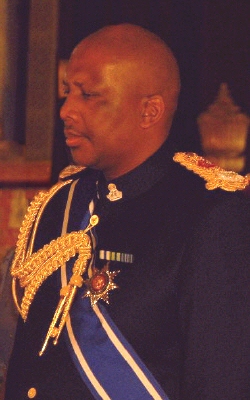
Cheers,
James
0 -
I have just heard about a recent Tongan medal. Apparently 45 soldiers were sent to the Gulf in support of American forces, and have been awarded the Campaign Medal:
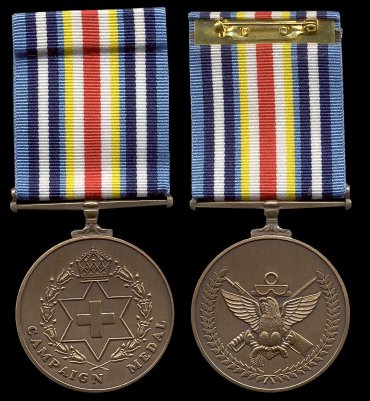
Very interesting to see this award, but one presumes that it is a campaign medal specifically for Iraq.
Until now, the Tongan Defence Services GSM has usually been awarded with a bar. At leas that was the case for previous campaigns, such as Bougainville.
Tongan soldiers have been serving in Iraq for quie some time. Recently the third contingent of 55 soldiers returned from their tour and have been replaced by the fourth contingent.
Cheers,
James
0 -
The ribbon in the picture posted above seems to be incorrect or at least outdated.
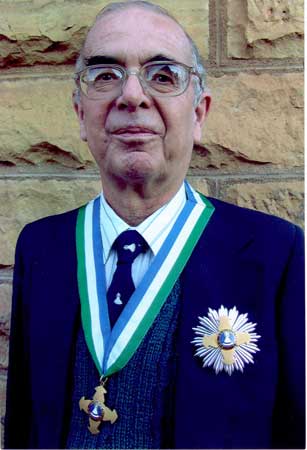
http://www.trc.org.ls/images/events_pictures/profambrose032006.jpg
The following details on Lesotho orders courtesy of Christopher Buyers and recent searches on the internet.
The Most Dignified Order of Moshoeshoe: founded by King Mosheshoe II in 1972 as the supreme dignity of the kingdom. Conferred on citizens of Lesotho and foreigners for distinguished leadership, particularly in the political sphere, in a single class (Knight Commander-KMDOM).
The Most Courteous Order of Lesotho: founded by King Mosheshoe II in 1972 as the principal order of the kingdom, conferred for exceptional services by citizens and foreigners. Awarded in three classes (1. Knight Commander-KMCOL, 2. Commander-CMCOL, and 3. Officer-OMCOL).
The Most Loyal Order of Ramat?eatsana: founded by King Mosheshoe II in 1972 as an award for distinguished service by members of the public service, armed forced and police. Awarded in three classes (1. Knight Commander-KCOR, 2. Commander-CMLOR, and 3. Officer-OMLOR).
The Most Meritorious Order of Mohlomi: founded by King Mosheshoe II in 1972 as an award to recognise achievement in the fields of community and social service. Awarded in four classes (1. Knight Commander-KMMOM, 2. Commander-CMMOM, 3. Officer-OMMOM, and 4. Member-MMMOM).
The titles of the orders or subsidiary titles given in Werlich seem to be the product of that author's misunderstanding with regard to the preamble titles and mottoes. There appears to be no "Order of Achievement". Rather, the order pictured is "The Most Meritoriosu Order of Mohlomi" which is awarded "for achievement" and has these words around its central design, on the badge and the breast star. Similar errors apply to Werlich in regard to his so-called "Order of Dignity" (actually The Most Dignified Order of Moshoeshoe) and his "Distinguished Service Order" (actually The Most Loyal Order of Ramat?eatsana).
The Lesotho orders were created with considerable advice from Sir Conrad Swann, Garter King-at-Arms, who was also responsible for advising on the establishment of the Order of Canada, Queen's Service Order of New Zealand, etc.
Cheers,
James
0 -
Order made of gilt "tompac". Diameter ? 40 mm. It has form of stylized convex rayed cross. In the center is circular silver medallion with child, woman and man. Around is inscription "Recunoştinţa Patriei", in the bottom is national flag of Moldova in natural colors. Cross is imposed into laurel wreath in relief. Badge of order attached to metal bar with enamels of blue, yellow and red colors. In the center of the bar is image of the flower in relief.
I don't know about reason, may be bad demographic situation?

Many thanks for the detailed description. Very useful and much appreciated.
You may be right about the demograpahic situation. I think that net migration is negative.
Cheers,
James
0 -
Your best bet would be to get hold of a 1926 edition of Burke's Peerage and work your way through the list of knights commander of the Order of the Indian Empire. This will list all those who were alive in that year. Then pick through those who also held the CSI at that date and narrow down your list. Given the method of wear for the CSI, the absence of a 1911 durbar medal and his apparent age, my guess is that the appointment to the CSI decoration dates from after 1917. Typically for tha period there should be about 7-10 civilian Europeans with that combination. When I say "civilian", this will include in the Political/Foreign Service who will also be entitled Colonel or Lieutenant-Colonel. I guess if there is someone with a Swedish connection, he may be your man.
The absence of any Durbar Medal may suggest that he wasn't actually an old India hand. Perhaps seconded from some other ministry (e.g. Treasury or War Office) or in the Foreign Service and serving in say Persia, Central Asia or the Gulf.
Cheers,
James
0


TRINIDAD AND TOBAGO
in Rest of the World: Militaria & History
Posted
Many thanks for yor ineresting and kind post.
From the original statutes it would appear that all the decorations, including the Humming Bird Medal and the Chaconia Medal, were part of the Order of Trinity.
Has the Order of Trinity been abolished or only the Trinity Cross?
If the Order has been abolished, do the medals now have their own separate statutes?
Cheers,
James